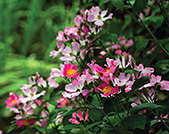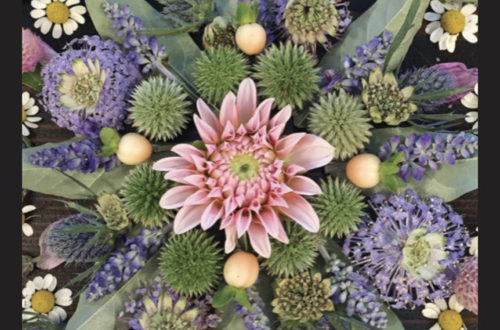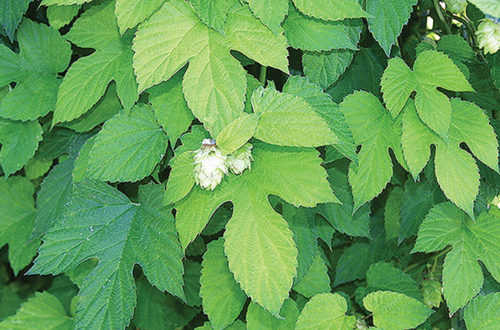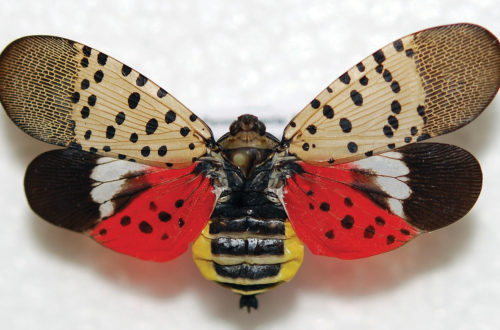This story first appeared in the spring/summer 2022 issue of Native Plant News.
The photo above is Swamp rose (Rosa palustris) with beetles.
By Neela de Zoysa with photographs by Uli Lorimer
Beauty, ecological value, utility, and versatility – our native roses have it all. Their striking, five-petalled pink blossoms with a crown of pollen-laden stamens are a visual delight in late spring. Their fragrant flowers attract a wide range of pollinators and transform into bright-red fruits, or hips, in late summer. The hips last through the fall and winter, providing winter color in the landscape as well as cold-season sustenance for birds and mammals. Native roses are tough, hardy shrubs and ramblers, equally at home on roadsides and swamp edges. Some have beautiful fall foliage and make great – and impenetrable – garden hedges. In general, they need little maintenance and are easy to cultivate. Their edible and medicinal properties also make native roses well-suited for permaculture.
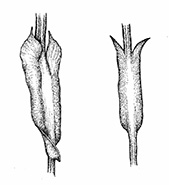
The leaf stipules of Rosa carolina (left) and Rosa virginiana (right).
New England is home to eight species of native North American roses, two of which have probably been introduced to this region. The six indigenous species are Virginia rose (Rosa virginiana), Carolina rose (R. carolina), swamp rose (R. palustris), smooth rose (R. blanda), shining rose (R. nitida), and bristly or prickly rose (R. acicularis). (The climbing rose R. setigera, native throughout much of North America, is thought to be introduced in New England, as is R. arkansana, or prairie rose.) Like milkweeds, some rose species are wide-ranging, while others prefer specific site conditions – wet and swampy, dry and sandy, and so on. Like most cultivated roses, nearly all our native roses need about six hours of sun.
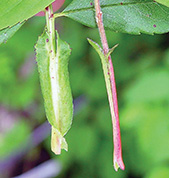
The leaf stipules of Rosa palustris (left) and Rosa virginiana (right).
Each and every part of the rose plant is a gift from the Earth. Native Americans in the Northeast have a long tradition of using rose leaves, bark, stems, and roots in medicines. Rose-hip extract, for example, can be used to hasten a woman’s labor during delivery. Emetics are prepared from rose bark, and cold treatments from rose stems. Rose hips are particularly nutritious and high in health-promoting phenolic compounds and other phytochemicals, including vitamin C. Native people consume the hips raw as well as in syrups, sauces, and medicinal remedies. Europeans, too, have a long culinary history with rose hips, incorporating them in tea, wine, syrup, jelly, and jam. Rose-seed oil is used to nourish the skin and reduce inflammation.
Humans are not alone in benefitting from all parts of the rose plant. Mammals and birds that eat rose hips include white-footed mice as well as ruffed grouse, northern mockingbird, and fox sparrow. Despite the prickles, white-tailed deer and other hoofed mammals browse the twigs and foliage. Cottontail rabbits nibble the lower shoots and foliage of young plants. All these animals help to distribute the seeds.
These plants are also important hosts for caterpillars of many moths and butterflies, and their dense, prickly thickets provide nesting habitat for birds and protection for small mammals. The abundant pollen of rose blossoms attracts various long-tongued bees, including honey bees and bumblebees, as well as short-tongued halictid bees, syrphid flies, bee flies, and beetles. Although the flowers of most roses do not provide nectar, several species do attract butterflies. According to research by entomologist Doug Tallamy, more than 100 species of butterflies and moths use rose plants as hosts for their caterpillars, which feed on their foliage. Other insects that native roses support include notorious pests of cultivated roses – shoot-boring beetles, flea beetles, scarab beetles, aphids, and the larvae of sawflies, gall wasps, and thrips – which consume shoots, leaves, and flowers. It helps to think of these insects and caterpillars as vital food for songbirds, bringing yet another tier of wildlife into your garden.
From the gardening standpoint, native roses do not require the cosseting that cultivated roses need. Cultivated garden roses depend on fertilizer and herbicides to perform well, but natives are less prone to the diseases that affect hybrids, including fungal blights such as black spot, powdery mildew, and rose rust. Many native roses, including the four we recommend for gardeners (see sidebar), also exhibit resistance to the mite-borne, viral rose rosette disease and offer the genetic variance that will confer resistance on cultivated species. (The invasive multiflora rose [R. multiflora] is the main host for rose rosette, an additional reason to clear it out.)
Native roses seem to be an ecological gardener’s dream, yet they represent less than two percent of the horticultural rose trade. Why are they overlooked? “I suspect that one of the main reasons is that roses are prized for their blooms, and though native roses are gorgeous when they bloom, that happens once a year and for a relatively short time,” says Native Plant Trust Retail Manager Noni Macon, who oversees the organization’s plant sales. “While native roses should be in every garden, the marketplace is filled with myriad competitors bred to bloom all season.”
That may be true, but for superior year-round interest, look to the natives. Rose cultivars and hybrids, bred to produce more petals at the expense of fertile parts (stamens), have lost their ability to produce hips, and their foliage does not change color in the fall. And most have lost what some gardeners consider the most precious attribute of roses, their fragrance.

Neela de Zoysa is a botanist and instructor at the Native Plant Trust. She’s a winner of the Les Mehrhoff Botanical Research Award from the New England Botanical Society and was a research associate for the Arnold Arboretum based at the Harvard University Herbaria.

Uli Lorimer is the Director of Horticulture at the Native Plant Trust. Previously, he was curator of Brooklyn Botanic Garden’s Native Flora Garden. He is the author of The Northeast Native Plant Primer.
Native Roses for New England Gardens
Native Plant Trust Director of Horticulture Uli Lorimer recommends the following four native roses for your garden. Their pedigree as garden specimens dates in this country to the 18th century, when Rosa palustris and R. setigera grew in the gardens of Thomas Jefferson and his contemporaries. R. virginiana and R. carolina were exported to Europe. For more information about these native roses, consult the Garden Plant Finder at www.NativePlantTrust.org/for-your-garden
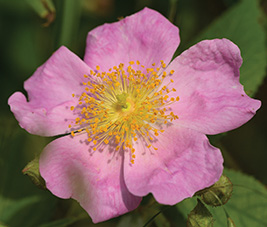
Carolina Rose or Pasture Rose – R. carolina
Plant of short stature, not exceeding three feet in height, that expands into a dense bush over time. With upright stems and few branches, this rose is great for hedges, mid-height in a flower border, and as a ground cover for restoring disturbed sites. Hips tend to blacken and shrivel in the winter, so it is not of winter interest. This rose grows in average to wet soils and is salt and drought tolerant. Exposure: Full sun to part shade.
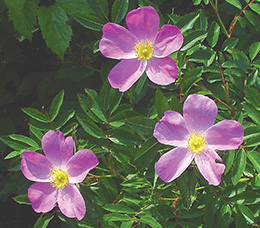
Virginia rose – R. virginiana
Similar to the Carolina rose in foliage, distribution, and growth habit, this rose is short and shrubby and also grows no more than three feet tall. (The leaf stipules, small appendages at the base of the leaf stalk, are the traditional way to tell them apart; in the Virginia rose they flare at the upper end.) Hips are globe-like and attractive. It grows in sandy and even saline soils and is suitable for both coastal gardens and cities. If fall foliage is a priority, this rose’s golden fall leaves are widely ranked as the most glorious in the genus. Exposure: full sun to part shade.
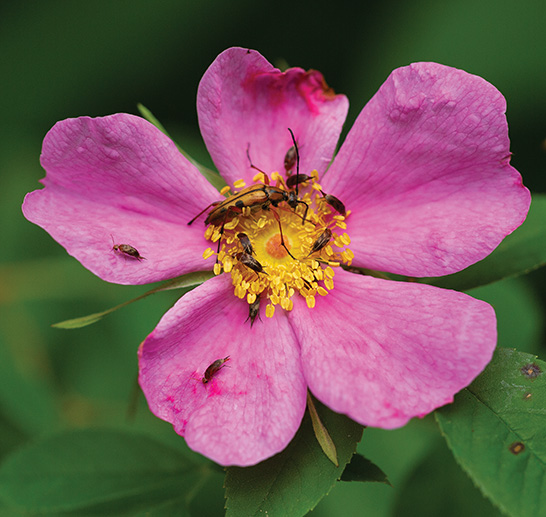
Swamp rose – R. palustris
Tall and graceful, growing to five to seven feet high, this can adapt to almost any soil type, including sandy soils. Especially good for wet-to-soggy soils where few other roses do well, and even for slightly submerged areas on the edges of ponds and streams. Exposure: full sun.
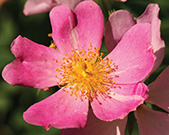
Climbing rose – R. setigera
The only native climbing rose, this also has a distinctive leaf that bears three leaflets, as opposed to five to seven in other species. It can climb up to 12 feet high and be trained on a trellis, allowed to trail, or planted in an informal hedge or naturalized thickets. It has great fall foliage and tolerates a wide range of soils and average to wet conditions. R. setigera is a dioecious species, requiring separate male (staminate) and female (pistillate) plants to produce fruit. Exposure: full to part sun.
